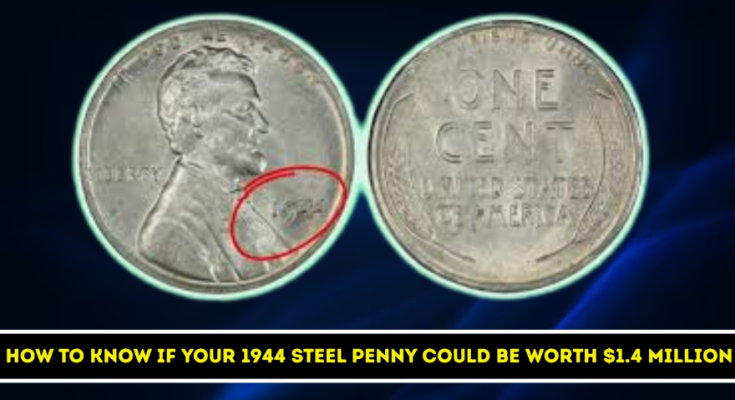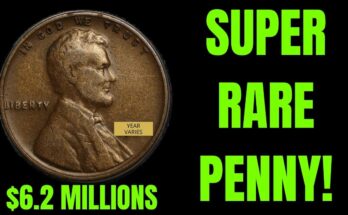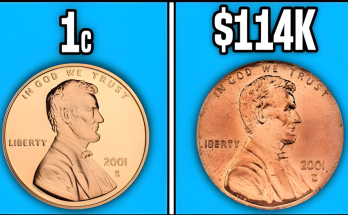Let’s be honest — the idea that a tiny coin in your pocket change could be worth a small fortune sounds almost too good to be true. But in the fascinating world of coin collecting, that’s exactly what can happen. One of the most legendary examples is the 1944 steel penny, a coin that’s made collectors’ hearts race and wallets open wide. If you happen to have one, you might just be sitting on a potential $1.4 million treasure.
So, how do you know if your 1944 penny is the one? Let’s take a deep dive — in plain, human terms — into what makes this coin so special, how to identify the real deal, and what to do if you think you’ve struck numismatic gold.
The Story Behind the 1944 Steel Penny
To understand why the 1944 steel penny is so valuable, we need to rewind to World War II. In 1943, the U.S. Mint stopped using copper for pennies because copper was needed for the war effort — think ammunition and electrical wiring.
Instead, the Mint produced pennies from zinc-coated steel that year. They looked silver-gray, not coppery-red like usual, and were lighter in color and weight.
Come 1944, copper returned for penny production. But here’s where the magic happened — a few leftover steel planchets (the metal discs used to make coins) from 1943 accidentally got mixed into the 1944 batch.
That tiny mistake created one of the rarest coins in American history: the 1944 steel penny.
Why It’s Worth Up to $1.4 Million
Now, not all 1944 pennies are valuable. In fact, most are copper and worth just a few cents. But those rare steel versions from 1944? They can fetch anywhere from $75,000 to over $1.4 million, depending on their condition and mint mark.
Here’s why collectors go crazy for them:
- Extreme rarity – Only about 20–30 are known to exist worldwide.
- Historical significance – Born out of a wartime error, these coins are a slice of American history.
- Collector competition – The fewer there are, the higher the bidding wars go.
How to Identify a Real 1944 Steel Penny
Before you start celebrating early retirement, you need to make sure your coin is the real deal. Counterfeits and altered coins are common, so it’s important to check carefully.
Here’s a simple identification checklist:
| Feature | Real 1944 Steel Penny | Regular 1944 Copper Penny |
|---|---|---|
| Color | Silver-gray | Reddish-brown or coppery |
| Metal | Steel (magnetic) | Copper (non-magnetic) |
| Weight | About 2.7 grams | About 3.11 grams |
| Sound | High-pitched “ting” when dropped | Duller “thud” sound |
| Mint Marks | May show “D” (Denver) or “S” (San Francisco) or none (Philadelphia) | Same, but common |
The easiest test? Use a magnet.
If your 1944 penny sticks to a magnet — that’s your first big clue. But don’t jump to conclusions just yet!
There are fake steel pennies made by removing the copper coating from regular 1944 pennies, giving them a silvery look. These will not stick to a magnet the same way a true steel penny does.
For absolute certainty, a professional grading service like PCGS (Professional Coin Grading Service) or NGC (Numismatic Guaranty Corporation) can authenticate your coin.
The Different Mint Versions
There are a few known types of 1944 steel pennies, and where they were minted can make a difference in value:
| Mint Location | Mint Mark | Estimated Value (in top condition) |
|---|---|---|
| Philadelphia | No mint mark | $100,000 – $1.4 million |
| Denver | D | $75,000 – $500,000 |
| San Francisco | S | $100,000 – $750,000 |
To find your mint mark, look just below the date on the coin.
How to Tell if It’s a Fake
Honestly, spotting fakes has become tougher because technology has made imitation coins more convincing. Still, here are a few classic red flags:
- Color looks too shiny or bluish. Real steel pennies have a slightly duller, zinc-like tone.
- Edges appear too sharp or uneven. The U.S. Mint’s coins have smooth, even rims.
- Non-magnetic. Real steel pennies are magnetic — no exceptions.
- Wrong weight. Weigh your coin. If it’s not around 2.7 grams, it’s probably not authentic steel.
When in doubt, get it graded and authenticated. It’s a small price to pay for peace of mind — and possibly a life-changing discovery.
What to Do If You Think You Have One
If your penny passes the magnet test and matches all the other traits, don’t clean or polish it. Cleaning can actually reduce its value drastically!
Here’s what you should do:
- Place it in a soft coin holder or envelope to avoid scratches.
- Contact a reputable coin dealer or grading service.
- Get it officially graded and authenticated.
- Once certified, you can auction it through trusted platforms like Heritage Auctions or Stack’s Bowers.
Finding a 1944 steel penny is like winning a mini-lottery for collectors. It’s rare, historically fascinating, and worth serious money. The odds are slim, but not impossible — people do still find these coins in old jars, inherited collections, or even pocket change from older family stashes.
So the next time you’re sorting through pennies, don’t just glance and toss them aside. Take a closer look. Because honestly, you never know — that dull silver coin might just make you a millionaire.
Frequently Asked Questions
1. How many 1944 steel pennies are known to exist?
Only around 20 to 30 authentic 1944 steel pennies are known to exist worldwide, making them extremely rare.
2. Are all 1944 pennies valuable?
No — most 1944 pennies are copper and worth just a few cents unless they’re in perfect condition or have errors.
3. How can I test my penny at home?
Use a magnet first. If it sticks and the coin looks silver-gray with a 1944 date, it’s worth professional verification.
4. Should I clean my 1944 penny before selling it?
Never. Cleaning can significantly reduce the coin’s value. Leave it as is.
5. Where can I sell a 1944 steel penny?
You can sell it through certified auction houses like Heritage Auctions or trusted coin dealers after authentication.



